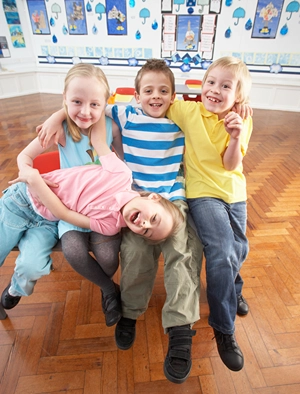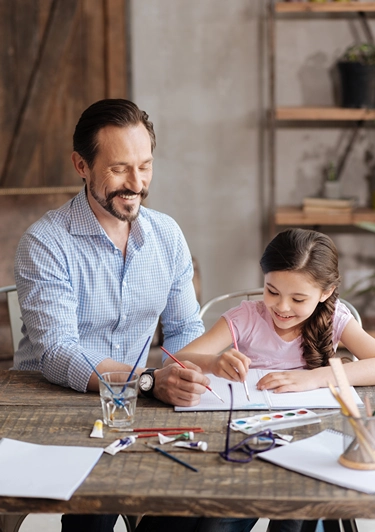ABA Therapy and Sibling Support: Enabling Siblings to Understand and Bond with Their Autistic Brother or Sister
Applied Behavior Analysis (ABA) therapy has quickly become one of the most sought-after and successful interventions to assist children with autism spectrum disorder (ASD). This evidence-based approach not only empowers children with ASD to develop essential skills but also fosters meaningful connections and positive dynamics within their families.
But its benefits extend far beyond helping individual children – when provided by an in-home ABA provider, not only does their sibling gain personalized care and intervention but they can also gain greater understanding, support and opportunities to form stronger bonds within the family unit. Engaging all family members in the therapeutic process ensures a harmonious family life full of shared growth.
Siblings of children with autism face unique emotional difficulties. They may feel confused by their brother or sister’s behaviors, uncertain how best to interact with them, and neglected as the focus of parental attention shifts away from them and onto the child with autism. That is why helping siblings understand autism and forging positive connections between them is so critical–both for emotional well-being of neurotypical siblings, but also for aiding the social and emotional development of the child with ASD.
Growing Up with Autism
Siblings of those diagnosed with autism can experience a range of emotions as they grow up together. While some may take pride in watching their sibling’s progress, others may become frustrated at his or her behavioral challenges or extra attention they require from others. Sometimes siblings may even feel embarrassed or isolated when others don’t comprehend or understand his or her behaviors.
ABA therapy plays an integral role in sibling relationships. By targeting challenging behaviors and strengthening social skills, ABA techniques often result in positive effects on sibling relationships. Home ABA providers can involve siblings directly in this process to foster an atmosphere of understanding and empathy between siblings; teaching neurotypical siblings how to respond appropriately when faced with specific behaviors may also help narrow any potential gaps between them that would otherwise widen due to miscommunication or misunderstandings.
Education and Empathy Through ABA
One of the first steps toward helping siblings’ bond with their autistic siblings is education. Neurotypical siblings must gain an understanding of autism and how it impacts their sibling to reduce confusion and fear that could otherwise create emotional distance between siblings. An in-home ABA provider can play an invaluable role here by not only meeting the needs of the child with ASD but also by educating everyone involved, including siblings, about its various manifestations.
ABA therapy emphasizes breaking complex tasks down into manageable steps, which is also true of teaching siblings about autism. By explaining behaviors like repetitive movements, sensory sensitivities or communication challenges to them, siblings can begin to understand why their brother or sister may act differently from peers. When siblings realize these actions aren’t intentional but instead natural responses from someone with special needs, empathy rather than frustration often emerges instead.
Neurotypical siblings can benefit from guided interactions with an ABA provider to learn how to respond appropriately to challenging behaviors and engage in positive social interactions, creating a foundation of connection that fosters better understanding between themselves as well as more harmonious relationships between siblings.
Practical Strategies for Sibling Inclusion
Engaging siblings in the ABA therapy process doesn’t need to create additional stress in their lives; rather, the goal should be creating positive experiences between siblings that bring them closer together. Below are a few strategies in-home ABA providers can employ in order to support sibling inclusion:
Inclusive Play:
Siblings often enjoy spending time playing together, and ABA therapy provides structured activities to make this possible. Our in-home ABA provider can arrange activities that encourage turn-taking, cooperative play or shared interests to foster positive interactions among siblings – which in turn can make neurotypical siblings feel more included into the world of their brother or sister with autism.
Sibling-Specific Training:
Empowering neurotypical siblings with basic ABA techniques such as positive reinforcement or redirection is an invaluable way to provide their brother or sister with support in small yet meaningful ways. They may learn how to reinforce appropriate behaviors during play time or follow routines more easily – training which makes the experience fun and easy, so siblings feel part of the therapy process itself.
Family Routines:
ABA therapy often centers on helping children with autism adapt to daily routines such as mealtimes, bedtimes and getting ready for school. Engaging siblings in these tasks can foster teamwork and shared responsibility between family members; in-home ABA providers can work closely with families in setting up routines that benefit all involved members while making sure siblings feel valued throughout.
Communication and Problem-Solving Skills:
ABA therapy places great emphasis on communication, and siblings of those diagnosed with autism can gain from learning how to effectively interact with one another through effective nonverbal and visual supports, understanding body language or developing patience when faced with challenging situations. By honing these skills together, they become better prepared to manage difficult moments while decreasing frustration levels and forging closer bonds between siblings.
Emotional Support for Siblings While education and practical strategies are critical, it’s also crucial that neurotypical siblings receive emotional support. Siblings may feel isolated or angry at times. Working with an in-home ABA provider can help families address these feelings by creating an atmosphere conducive to expression.
Regular family meetings led by their ABA provider provide siblings with an open channel of communication to voice any grievances or frustrations that may be plaguing them, helping both parents and therapists understand more fully their perspectives as well as providing opportunities for problem-solving. Furthermore, discussions such as these help support siblings feel less alone and reduce feelings of isolation.
Sibling support groups can often be beneficial. Sibling support groups allow children to connect with others who share similar experiences, helping alleviate feelings of being “different” while providing an outlet for emotional expression.
Long-Term Benefits of Sibling Participation
Sibling participation in ABA therapy sessions can bring long-term advantages to a family unit as a whole. When siblings foster close ties with their sibling with autism, he or she often feels more supported and secure – this may help enhance progress in therapy sessions as well as quality of life improvements overall. Neurotypical siblings participating also tend to gain more sense of responsibility, empathy, and emotional resilience from such involvement.
Over time, siblings who grow up alongside a sibling with autism can become powerful advocates and sources of support. By beginning this process early with guidance from an in-home ABA provider, families can build bonds between siblings that are built upon understanding, compassion, and mutual respect – creating lifelong bonds between sibling relationships that form over time.
Conclusion
ABA therapy holds immense promise to not only transform the lives of children with autism but also support their neurotypical siblings in meaningful ways. With help from an in-home ABA provider, families can navigate together the challenges associated with autism; creating stronger sibling relationships while creating a home environment in which all members feel valued and understood. By including siblings in therapy processes such as this one, families can form lasting connections that bring happiness and harmony for everyone involved.
Interested in a Careers in ABA Therapy? Read how to study effectively for the RBT exam.








